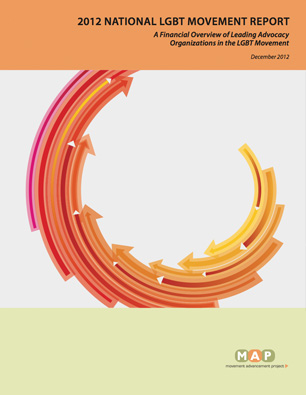The Bottom Line
The National LGBT Movement Report, published annually by MAP, examines revenue and expenses, fundraising and fundraising efficiency, and other indicators of financial health for lesbian, gay, bisexual and transgender (LGBT) social justice advocacy, issue, legal, research and public education organizations.
- 2012 National LGBT Movement ReportDownload
- 2011 National LGBT Movement ReportDownload
- 2010 National LGBT Movement ReportDownload
Abstract
The 2012 National LGBT Movement Report provides a comprehensive snapshot of the financial health of LGBT social justice advocacy organizations. The 40 organizations examined for the 2012 report collectively represent 69% of the budgets of all LGBT social justice advocacy organizations. Among the key findings in the 2012 report:
Revenue and Expenses. Following several years during which organizations’ revenue declined, leaner and more flexible LGBT social justice organizations are reaping the benefits of belt-tightening years and increased efficiency. LGBT movement experienced a 17% increase in revenue from 2010 to 2011. Participating organizations are projecting expense budget increases of 13% for 2011.
Fundraising and Fundraising Efficiency. The number of individual donors increased from 2010 to 2011 after several years of declines. Additionally, fundraising operations continue to be efficient, with only 12% of expenses spent on fundraising, and 80% going directly to programs and services—surpassing benchmarks of the American Institute of Philanthropy and Better Business Bureau Wise Giving Alliance.
Other Indicators of Financial Health. Other indicators remain strong. Increases in revenue and decreases in expenses have allowed organizations to increase cash and investments. The average organization had nearly six months of working capital in 2011.
Staff and Boards. LGBT organizations’ paid staff is roughly representative of the broader U.S. population, with 34% of staff identifying as people of color and 49% identifying as women. Seven percent of staff identify as transgender.
2012 Participating Organizations
ACLU LGBT & AIDS Project
Audre Lorde Project, Inc.
Basic RIghts Oregon
CenterLink
Council for Global Equality
Empire State Pride Agenda
Equality California
Equality Federation
Family Equality Council
Freedom to Marry
Funders for LGBTQ Issues
Gay & Lesbian Advocates & Defenders (GLAD)
Gay & Lesbian Alliance Against Defamation (GLAAD)
Gay & Lesbian Victory Fund and
Leadership Institute
Gay, Lesbian and Straight Education Network (GLSEN)
Gay-Straight Alliance Network
GroundSpark
Human Rights Campaign and Foundation (HRC)
Immigration Equality
In the Life Media
Keshet
Lambda Legal
Log Cabin Republicans
MassEquality
National Black Justice Coalition (NBJC)
National Center for Lesbian Rights (NCLR)
National Center for Transgender Equality (NCTE)
National Coalition for LGBT Health
New York City Gay and Lesbian Anti-Violence Project
Out & Equal Workplace Advocates
Parents, Families and Friends of Lesbians and Gays (PFLAG)
Point Foundation
Servicemembers Legal Defense Network
Services & Advocacy for GLBT Elders (SAGE)
Soulforce
Sylvia Rivera Law Project
The Task Force
Transgender Law Center
The Trevor Project
(One organization preferred not to be listed.)



